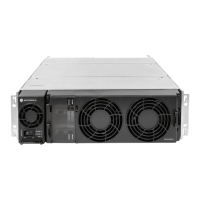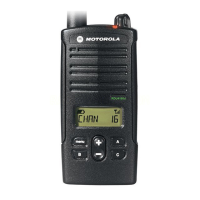3-2 Theory of Operation
The RF Board is a multi-stage power amplifier board that contains the Driver Amplifier and final
amplifier circuits, and is the interface to the Exciter module output. The Output Board contains the
harmonic (low-pass) filter and directional couplers for forward and reverse power sensors, and is
connected to the PA output/antenna port. The Distribution Board contains the PA SPI circuitry,
diagnostic metering circuitry, RF power control circuitry, and the fan power supply, and is the
interface to the site control module (SCM) and power supply module (PS). The SPI circuitry within
the PA includes the analog to digital converter (A/D), digital to analog converter (D/A), non-volatile
memory (NVM), and the customer programmable logic device (CPLD). The PA and its sub-modules
are broad-band and require no manual tuning or alignment to operate at the station site over the
specified rated conditions.
The station PS provides 28.6 V and 14.2 V supplies to the PA through a direct connection. The PA
utilizes these voltages to supply power within the PA to the various sub-circuits described herein.
Additional internal voltages of 3.3 V and 5 V are derived from the 14.2 V supply within the PA, and
these are used to supply certain peripheral circuitry within the PA.
Within the PA, the input RF signal is initially amplified by the Driver Amplifier stages, and is then
further amplified by the final amplifier stage. The Driver Amplifier is gain-controlled by a control
voltage, V_Control, provided by the power control loop within the PA. The final amplifier is a fixed-
gain amplifier stage, and is the last stage of RF amplification within the PA. The amplified RF signal
then passes from the final amplifier through an isolator and harmonic filter, through the directional
couplers for power detection, and then out of the PA output port.
The directional coupler is a calibrated wattmeter, with its calibration information stored in the PA
NVM. The forward power wattmeter provides a DC voltage corresponding to the measured output
power to the A/D for metering purposes, so that SW can monitor the PA or the base station/repeater
output power. Also, this voltage is provided to the power control circuitry within the PA to serve as
the feedback signal in the power control loop. Using the unique PA calibration information stored in
the NVM, SW can control the PA output power level via the SPI bus from the SCM through the PA
signal connector. SW controls the transmit power by programming the D/A within the PA power
control circuit to a specific DC reference voltage corresponding to the desired output power based
on the calibration information. Under normal operating conditions, the power control circuitry
compares the DC voltage from the directional coupler to the reference voltage from the D/A, and
based on the comparison a control voltage is generated that controls the PA gain to yield the
requested output power from the PA module.
The SW requested output power level may include one or more SW controlled adjustments based
on various alarm conditions generated from monitored PA metering signals which are fed back to
the SCM via an A/D converter (also connected to the SPI bus). Using the A/D metering circuits, SW
monitors for conditions such as high reflected power/VSWR or high/low supply voltages and takes
action to reduce output power or dekey the station accordingly to protect the HW from damage or
improper operation. During excessive output VSWR, the ratio of the forward and reflected voltages
from the directional coupler may be used by software to reduce, or turn off, the transmitter power
based on the reflected power level and severity of the VSWR. Likewise when the main PA supply
voltage level is outside of its nominal range, the output power is reduced by SW accordingly to
protect the HW.
Temperature sense circuitry is also contained within the PA and is used to monitor the PA internal
temperature. When the temperature reaches a certain threshold, the PA fan will power on to reduce
the operating temperature of the PA. If the temperature continues to rise and reaches another
predefined threshold, it will begin to impact the power control loop and will result in an output power
reduction in order to protect the HW from thermal failure. When this latter threshold is exceeded, it
provides a voltage contribution into the power control loop feedback and results in a reduced output
power. Both the fan control and the power control manipulation for thermal protection is fully HW

